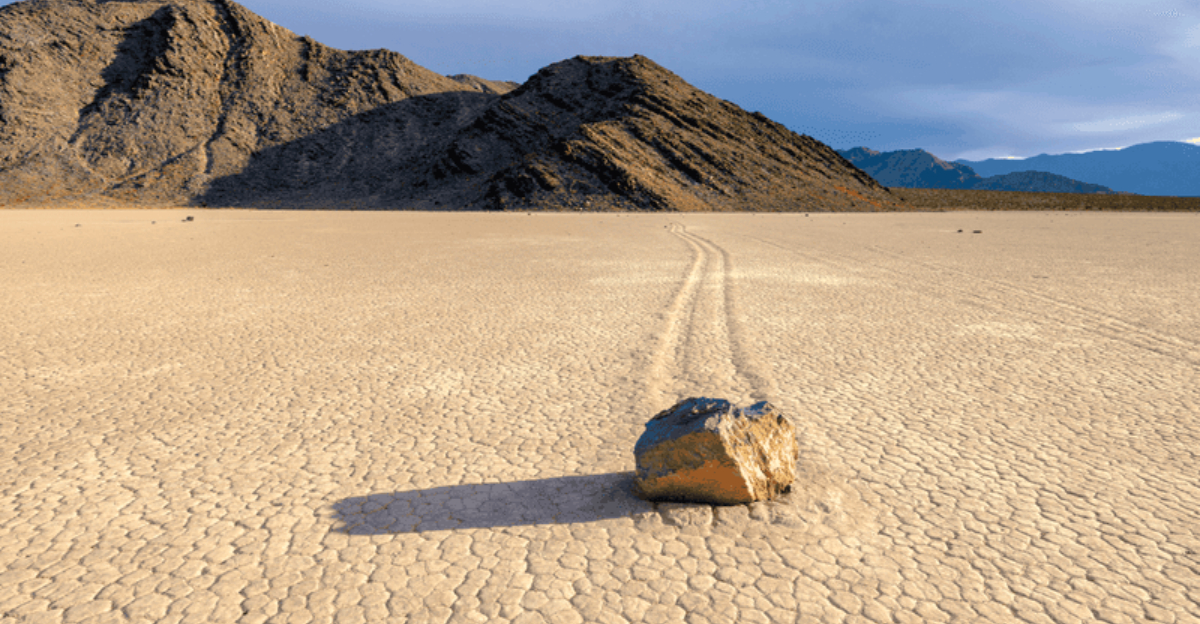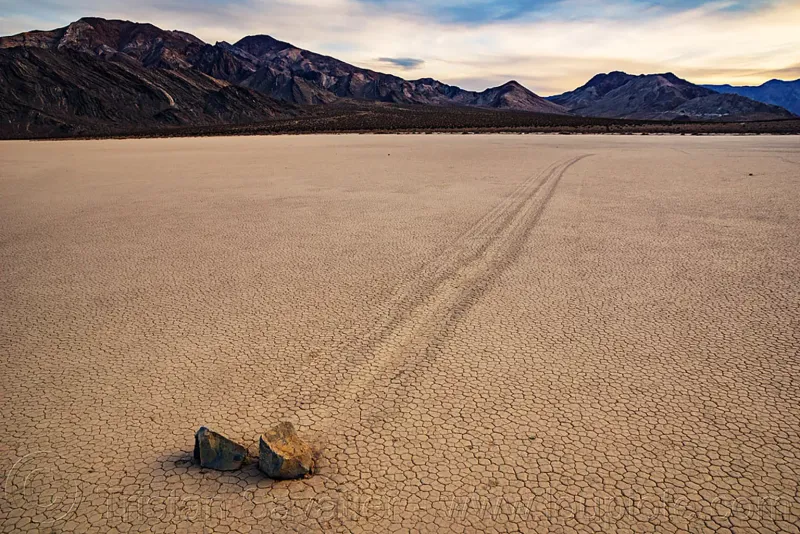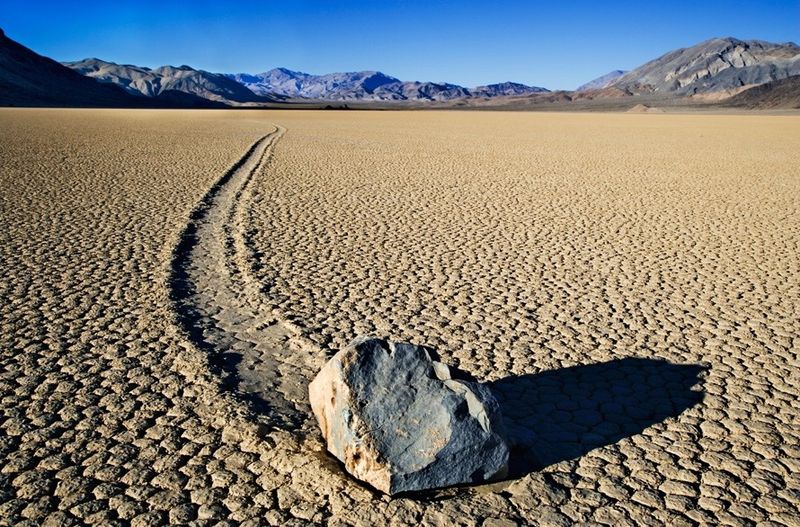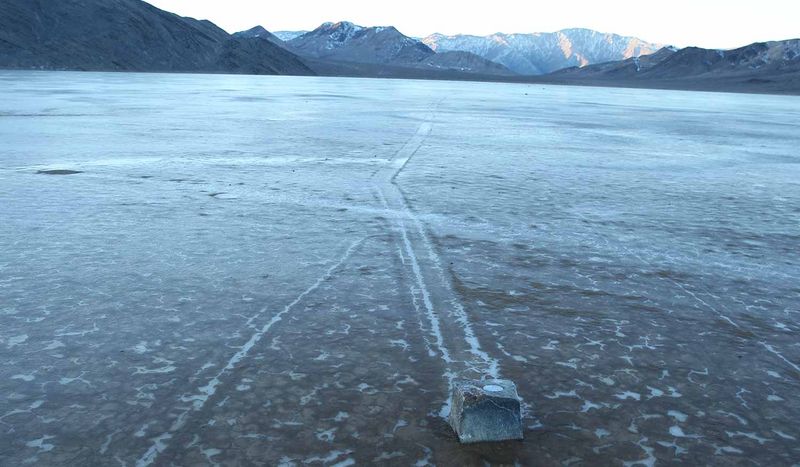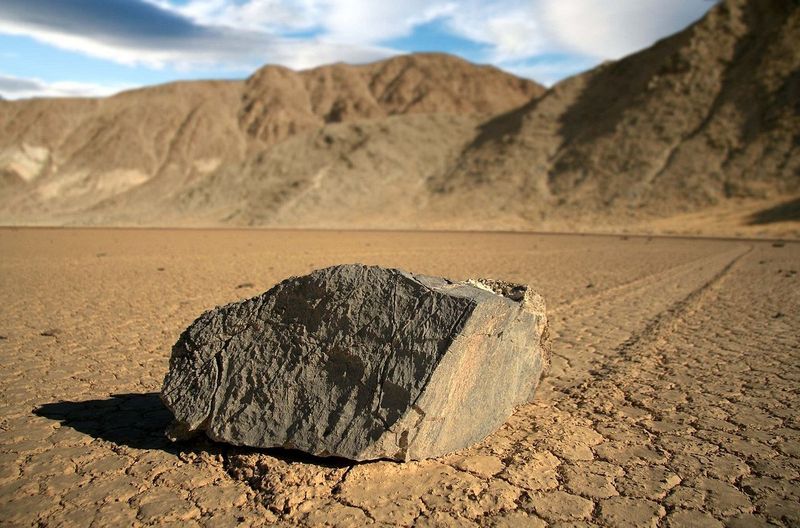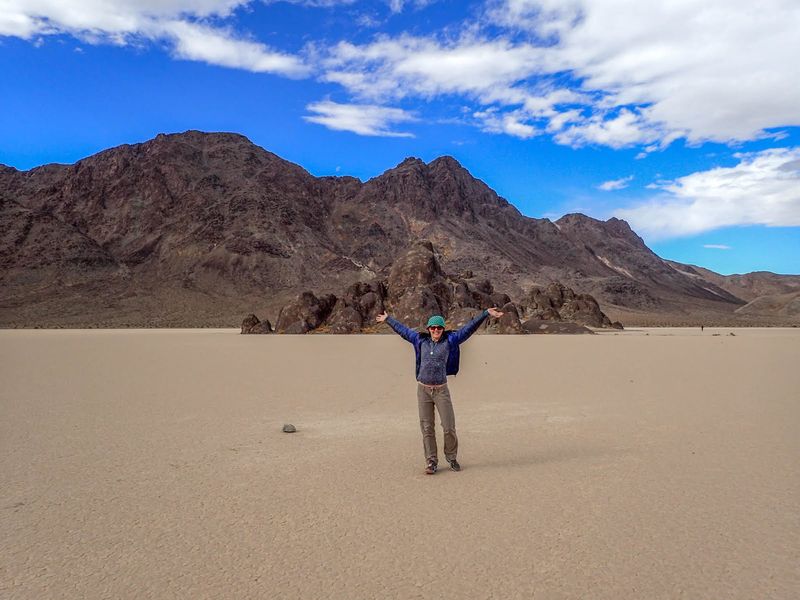Deep in Death Valley National Park lies one of nature’s most puzzling mysteries: rocks that appear to move on their own across a flat, dry lakebed. These sailing stones leave long trails behind them, some stretching for hundreds of feet, yet for decades nobody saw them actually move. Scientists scratched their heads for nearly a century trying to solve this riddle, until a breakthrough discovery finally revealed the secret behind this strange phenomenon.
1. A Remote Stage with Perfect Conditions
Racetrack Playa sits like a giant stage waiting for nature’s performance. This dry lakebed stretches about 4.5 kilometers by 2 kilometers at an elevation of 1,132 meters, making it one of the flattest places on Earth.
The surface is cracked clay that transforms into a slippery ice rink when water freezes on it. Because the ground is so incredibly level, even tiny forces can push a heavy rock across it.
The basin catches rare rainfall and runoff, creating the perfect conditions for the mystery to unfold. Once a stone leaves its mark, the track stays visible for years in this featureless landscape, creating a permanent record of its journey across the playa.
2. From Eyewitness Mystery to Scientific Enigma
Back in 1915, a prospector named Joseph Crook stumbled upon something that didn’t make sense. He found boulders that looked like they had moved overnight, leaving tracks behind them in the mud.
For decades afterward, geologists mapped the trails, measured the rocks, and came up with wild theories. Some thought powerful winds pushed them, while others suggested magnetic forces or even earthquakes were responsible.
The frustrating part? Nobody ever caught a rock in the act of moving. It wasn’t until nearly a hundred years later that scientists finally witnessed the phenomenon with their own eyes and cameras, solving one of geology’s longest-running mysteries.
3. Some Stones Are Goliaths
Forget pebbles—some of these rocks are absolute giants. The heaviest sailing stones weigh around 700 pounds, yet they still manage to slide across the playa, leaving trails that can stretch for hundreds of meters.
Imagine trying to push a refrigerator across your kitchen floor. Now imagine it moving by itself with only gentle breezes helping it along.
The fact that such massive rocks can move at all tells scientists something important about the delicate balance of conditions needed. It takes just the right combination of water, ice, and wind to get these heavyweights gliding across the desert floor like hockey pucks on an ice rink.
4. The Trails Tell Their Stories
Every rock writes its own story in the clay. Some paths run straight as an arrow, while others twist and turn like a maze. Hundreds of these trails crisscross the playa, creating patterns that look almost artistic.
Wind erosion and new cracks slowly erase the older tracks over time. This means the playa’s “memory” fades after a few years, making room for new stories to be written.
Scientists have become detectives, comparing old maps with satellite images to track certain stones over long periods. By studying these paths, they can piece together when movements happened and what conditions might have caused them, building a timeline of the playa’s secret life.
5. The 2014 Breakthrough: Ice Plus Wind in Perfect Harmony
Richard Norris and his team finally cracked the case in 2014 using GPS trackers and time-lapse cameras. What they discovered was beautifully simple yet required perfect timing.
On cold winter nights, shallow ponds form and freeze into thin ice sheets. When the sun rises, the ice cracks into floating panels that drift over the wet, slippery clay beneath.
Light breezes—not powerful winds—push these ice rafts, which carry the rocks along for the ride. The ice can’t be too thick or it won’t budge; too thin and it breaks apart without moving anything. Wind speeds stay surprisingly mild, just strong enough to nudge the fragmented ice across the surface.
6. The Movement Is Rare and Slow
Don’t expect to see rocks racing across the desert. Movement happens only every few years, depending on whether rain falls, temperatures drop enough to freeze water, and conditions align just right.
When rocks do move, they’re not exactly speed demons. Scientists measured speeds of about 80 millimeters per second during ideal conditions—roughly 5 meters per minute.
That’s slow enough that you might not even notice it happening if you were standing there watching. But it’s fast enough to leave clear marks in the soft clay. The rarity makes witnessing this event feel like spotting a shooting star—magical because it doesn’t happen often.
7. Visiting the Racetrack: A Walk Among Mystery
Getting to the Racetrack Playa is an adventure in itself. The site sits at the end of rough backcountry roads that demand high-clearance vehicles or four-wheel drive for safe passage.
The Grandstand, a dark rock outcrop rising dramatically from the flat surface, serves as both landmark and perfect photo opportunity. When you walk onto the playa, remember to stay off fragile areas and never touch the stones or disturb their tracks.
Winter to early spring offers your best chance to visit when the magic might happen. Pack plenty of water, check your vehicle, and tell someone your plans—cell service doesn’t exist out here in this remote corner of wonder.
